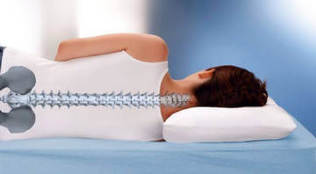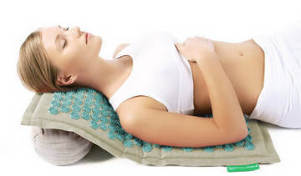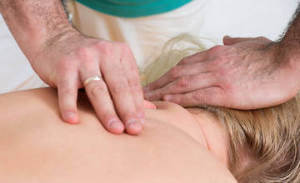
Cervical lumbar osteochondrosis is a progressive dystrophic process, a disorder of the intervertebral discs.
The symptoms of cervical osteochondrosis are characterized by severe pain in the neck, head and shoulders and affect everyone, regardless of age.
DESCRIPTION WITHOUT OSTEOCHONDROSIS
Osteochondrosis of the neck has become much younger. Young people suffer from this from a young age. The neck is the weakest part of the waist. The seven vertebrae are very tightly connected, and the skeletal part of the muscles is less developed than the rest. The neck is under severe stress because it acts as a support for the skull and is in constant motion.
What is cervical osteochondrosis? The intervertebral discs are nourished by proliferation from neighboring tissues. Deterioration of the blood supply to the tissues surrounding the vertebrae leads to malnutrition and dehydration. Starvation of the disc nucleus and annulus fibrosus leads to degenerative processes.
Excessive bone growth near the vertebrae, compressed intervertebral discs, and compressed nerves and ligaments initially appear as signs of decreased performance. High-intensity pain initially concentrates in the neck, head, shoulders, heart, arms, and upper chest and moves to the lower extremities. Each of the seven vertebrae sends a signal to other departments. Compressed nerve roots affect the condition of other body systems.
Osteochondrosis is especially dangerous for the brain. The vertebral artery, which works here, performs the function of supplying blood to the back of the brain. Pinching turns into a headache that is not subject to painkillers, often migraines. Osteochondrosis of the neck may be accompanied by dizziness, visual and hearing impairment, nausea and vomiting. Later, pharyngeal symptoms appear, and he suddenly faints due to lack of oxygen supply to the brain. Compression of the vertebral artery causes spinal cord and cerebral ischemia. Complicating the process causes a spinal cord injury.
MAIN PROCESSES IN DISEASE
Osteochondrosis of the neck should be considered in terms of the interaction of physiological and pathological factors:
- Physiological process:Aging of spinal cartilage occurs due to natural irreversible causes. Changes occur in the central part of the intervertebral disc. The process of age-related changes in the body leads to the replacement of the pulp with fibrous tissue;
- pathological process:degenerative changes in intervertebral structures, destruction of surrounding vessels and nodes. The changes occur outside the cartilage, there is constriction of blood vessels, irritation of nerve endings. A person feels the symptoms of dysalgia, pain of a local and reflected nature.
Osteochondrosis of the cervical spine takes a pathological form when physiological aging is replaced by a pathological process. First, it compensates for the disease by activating the body's compensatory and protective mechanisms. Therefore, osteochondrosis can occur only occasionally. However, this feature is not permanent.
The progression of the disease, expressed in the compression of vascular and nervous structures, is accompanied by the following processes:
- Spondylolisthesis in which the spinal disc slides. Even a small displacement can lead to the development of paralysis. Violent displacement is fatal;
- pulposus nucleus is impregnated with calcium salts. This causes the disc to feed, causing a hernia to form;
- Intervertebral hernia caused by the protrusion of the intervertebral disc between the vertebrae. Ignoring therapeutic measures leads to dumb paralysis;
- Appearance of micro-cracks in annulus fibrosus, development of protrusions. Extends beyond the intervertebral disc;
- Spondylosis, which means erosion of the vertebrae. Osteophytes form - growths of bone tissue in the form of hooks and thorns localized at the edges of the vertebral bodies. There is severe pain and consequently stiffness of movements.
CAUSES OF OCCECHONDROSIS OF THE NECK

Increased cervical spine load causes the body to try to compensate for the condition. Muscle spasms, deterioration of blood circulation, deformities begin. The structure of the vertebrae itself changes. The cause may also be progressive discosis caused by prolonged physical exertion.
The main factors that lead to the onset of cervical osteochondrosis:
- hypodynamics;
- weakening of the immune system;
- excessive physical activity;
- presence of spinal cord injuries;
- malnutrition of the main substances, obesity;
- posture problems (scoliosis, flat feet, rheumatism);
- hereditary factor;
- autoimmune diseases that cause cartilage degeneration;
- stress, long-term nervous tension;
- climate factor, cold and humidity;
- Congenital anomalies of the spine.
The main causes of osteochondrosis are disproportionate distribution of spinal load, very weak muscle corset. People over the age of thirty are at the greatest risk, especially if they spend their days sitting for long periods of time.
STAGES OF DEVELOPMENT
The progression of cervical spine osteochondrosis can be divided into several stages:
- initially
- , preclinical.Slight deformities of the vertebrae are characterized by the smoothness of the cervical lordosis. The pain is felt by sudden movements of the head, there is fatigue. The development of the disease can be prevented without medication. You need to balance your diet, choose exercises and take preventive measures;
- seconds.An unstable situation is created between the vertebrae. There are changes in the vertebrae relative to each other, torsion - rotation around the spine. The pain, which intensifies from time to time with neck movements, spreads to the shoulders and arms. The height of the intervertebral discs decreases, which leads to compression of the nerves. It is characterized by symptoms such as dizziness, fatigue, headache;
- third stage.The height of the intervertebral disc is reduced by a quarter compared to the superior disc. Deformities begin to appear in the intervertebral joints. There is a decrease in the lumen of the spinal canal, the spinal canal. Severe pain is always felt. Due to the formation of herniated intervertebral discs, the arm muscles begin to coagulate. The cervical spine loses elasticity. The patient feels dizzy and weak.
The height of the intervertebral disc is significantly reduced. Intervertebral discs are destroyed and replaced by connective tissue. Large osteophytes form behind the cervical spine. The spinal canal becomes very narrow and causes the development of myelopathy. The patient's condition worsens, accompanied by loss of coordination, dizziness, severe pain, tinnitus.
SYMPTOMS
The symptomatic picture of a neck injury differs from the disorders in other parts. This is due to the fact that the vertebrae are closer together. Due to the small height of the intervertebral discs, the clinic begins to show itself even with mild pathologies. Symptoms of injury will vary depending on which of the eight nerve roots is affected. There is a nerve under each of the seven vertebrae, and compression has its own symptoms.
Problems in the first two vertebrae affect the sensitivity of the occiput. The pain is localized in the parietal, occipital region. Defeat of the nerve ending of the third vertebra is rare. Symptoms include numbness, tingling, and speech problems. The fourth root indicates pain and numbness in the clavicle and shoulder. Difficulty breathing can cause pain in the heart. The disease of the fifth segment causes pain in the shoulders and decreased sensitivity of the limbs.
Lesions of the sixth and seventh vertebrae are the most common among patients. Suffers from neck, shoulder blades, wrists, back, spine. There is numbness in the hands and fingers. Pathological changes in the eighth nerve root are characterized by the spread of pain in the lower extremities. There is a loss of sensitivity in the skin, numbness of the little fingers on the hands and feet. Circulatory disorders cause the legs and hands to turn blue.
The general symptoms of cervical osteochondrosis are:
- pain spreading to the upper and lower body;
- weakness, decreased sensitivity of the hands;
- difficulty in movement, crunch;
- Poor coordination accompanied by ringing, tinnitus, malaise, weakness, dizziness;
- nausea, vomiting;
- Tongue, fingers and toes numbness, hearing, vision impairment.
Diagnosis of cervical osteochondrosis
To determine the degree of damage to the damaged intervertebral discs and their disease, the doctor must perform a series of examinations: X-ray, MRI, CT (computed tomography), ultrasound duplex scanning. The most accurate way to examine cervical spine health is magnetic resonance imaging (MRI). The purpose of MRI is to identify pathological changes in the tissues of the spine, especially in the spinal cord and intervertebral hernias. After examination and inquiry of the patient, the attending neurologist makes an initial diagnosis and prescribes treatment.
TEDAVİSİ

If you suspect osteochondrosis, you should consult a neurologist. The duration of therapy depends on the age of the person, the severity of cervical osteochondrosis, the type of therapy and the patient's compliance with all medical recommendations. Complete treatment is not possible for severe forms of osteochondrosis. The purpose of complex treatment is to slow down the ongoing pathological process and eliminate the symptoms. Therapy can be conservative, operative, or a combination of both. If the headaches increase more often, therapy should be started as early as possible.
There are two main types of treatment for cervical osteochondrosis:
- medication, is carried out by taking medication;
- physiotherapy includes UHF, electrophoresis, ultrasound, magnetotherapy, laser therapy courses. They have a stimulating effect to relieve blood flow, metabolism and muscle spasms.
Medications are used to reduce the compression of peripheral areas of the central nervous system (CNS) and to correct pain syndrome when the disease is exacerbated. Therapy is not stopped after the acute manifestations of cervical osteochondrosis are eliminated. Physiotherapy is prescribed. The neck area should be massaged regularly. Folk remedies are also used.
MEDICAL TREATMENT OF OSTEOCHONDROSIS
Drug treatment will only be effective if combined with other methods, such as physiotherapy exercises (exercise therapy) and massage. The drugs are designed to reduce pain, restore cartilage tissue regeneration and activate blood circulation in the affected neck tissues.

Many doctors prescribe needles to be more effective at nerve endings. However, vitamins are best taken in pill form because needles are very painful. The doctor prescribes intramuscular injections to have an anti-inflammatory effect.
The main types of therapy drugs:
- Non-steroidal anti-inflammatory drugs (NSAIDs).It has an analgesic effect, eliminates aseptic inflammatory process, root edema. With obvious symptoms, these drugs are injected twice a day. Use a cream locally;
- chondroprotectors.Activate metabolism, restore cartilage tissue. Eliminate damage to the intervertebral discs. There are drugs that can be injected into the joints and muscles. The course of therapy lasts up to 4 months;
- B vitamins (B1, B2, B6), E, A, C, Dhelp to improve metabolism in tissues, catalyze their regeneration;
- muscle relaxant.To relax spasmodic muscles. The tablets are used for a month. In a severe form of the disease, various drugs that can be injected are used;
- drugs that activate blood flow in the brain,rheological properties of blood.
The following are used as additional medications to speed recovery:
- angioprotectors- injectable forms of the drug are designed to activate blood flow in the arteries, to strengthen vascular tone;
- glucocorticosteroids- to reduce edema and inflammation in the form of injections;
- biogenic stimulants.Accelerate metabolic processes, help regenerate damaged tissues.
PHYSIOTHERAPY
Physiotherapeutic methods complement drug treatment, significantly increase the rate of recovery, prolong the remission phase and reduce the frequency of exacerbations.
Physiotherapy methods:

- Sports therapyis one of the most effective ways to treat osteochondrosis. Regular exercise activates blood circulation, helps to repair injuries;
- massageimproves nerve conduction, restores muscle tone;
- magnetotherapyeliminates tissue edema;
- laser therapyworks with concentrated optical radiation. Begins recovery processes in the body;
- reflexology- activation of certain points. Strengthens the immune system, relieves spasms and neck pain;
- ultrasoundhas analgesic, anti-inflammatory effect;
- Electrophoresis with herbs.Electric current stimulates the penetration of drug ions into a certain area.
Manual therapy, thermotherapy, mud therapy are also used to get rid of cervical osteochondrosis. All these methods slow down the development of the disease.
Osteochondrosis cannot be treated with herbs, but they can help alleviate the condition by accompanying basic therapy. Mix two teaspoons of bee honey with two mummy tablets. The mixture is heated, apply a warm scarf around his neck at night. The biostimulating properties of honey perfectly complement the treatment. For grinding, use a tincture made from radish, vodka and honey, measured in cups in a ratio of 1, 5: 0, 5: 1. You can wrap three large lemons using a meat grinder with four garlic cloves. Pour boiling water over the mixture in a two-liter bowl. After mixing the contents, half a cup on an empty stomach. The pain can also be relieved by heating with mustard plasters and pepper plaster.
Healing Exercises
You can do a number of therapeutic exercises for the neck during the recovery period. Sports therapy is based on several dynamic exercises. You should not do gymnastics during exacerbations. It is recommended to watch the appearance of discomfort when performing exercises, it is unacceptable.
In a prone position, use your arms by lifting your body from above. Postpone for 1-2 minutes. Lower to the starting position and repeat 2-3 times. Then you should stretch your body along your body. Dizziness is done 6-7 times to the right and left, trying to reach the ground by ear. Sit down. While breathing, lean your body forward, head tilted towards your chest. On exhalation, bend your head back and forth. Enough 10-15 inclines. Now put your palms on your forehead and apply mutual pressure for 30 seconds. Repeat 2-3 times. Turn your head 10 times in each direction. If your head starts to spin, training should be stopped.
complications

The cervical region is rich in blood vessels and nerve endings that nourish the brain. The slightest compression of them damages the whole body, disrupts blood circulation in the brain and causes neurological diseases: migraine, heart, respiratory system, vision, hearing, hypertension. A complication in the form of vertebral artery syndrome, cerebral ischemia, spinal cord injury, which arises from an advanced form of neck disease, is especially dangerous. When radiculopathy occurs, mobility is lost. Spinal cord compression is fatal.
In the treatment of cervical osteochondrosis, it is impossible to delay the visit to the doctor at the first sign to prevent surgery. It is necessary to use all available therapies, as well as lifestyle changes and nutrition.












































